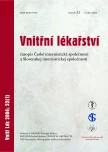Vascular complications after direct percutaneous coronary interventions
Authors:
M. Orban 1; O. Hlinomaz 1; F. Lehar 1; M. Rezek 1; M. Eisenberger 1; Z. Konečný 2; L. Groch 1
Authors‘ workplace:
I. interní kardio-angiologická klinika Lékařské fakulty MU a FN u sv. Anny, Brno, přednosta prof. MUDr. Jiří Vítovec, CSc., FESC
1; II. chirurgická klinika Lékařské fakulty MU a FN u sv. Anny, Brno, přednosta doc. MUDr. Jindřich Leypold, CSc.
2
Published in:
Vnitř Lék 2006; 52(1): 51-56
Category:
Original Contributions
Overview
Objectives:
We assessed the rate and identified risk factors for postprocedure vascular complications following direct percutaneous intervention (dPCI).
Methods:
Data were collected on 881 consecutive patients who underwent dPCI in our cath-lab from January 2002 to December 2003. Multivariate regression was used to identify characteristics associated with vascular complications.
Results:
Out of 881 patients, hematoma was found in 148 (16,8 %) cases. Pseudoaneurysm was detected by ultrasound in 40 (4,5 %) patients, 5 (0,6 %) patients underwent surgery. Variables associated with increased risk included age, female sex, low body mass index (BMI) and body surface area (BSA) and presence of diabetes mellitus.
Conclusions:
Predicting the risk of post-PCI vascular complications is feasible. This information may be useful for clinical decision-making and institutional efforts at quality improvement.
Key words:
pseudoaneurysm - direct percutaneous coronary intervention - myocardial infarction
Sources
1. Winthrop D, Piper, David J et al. Predicting vascular complications in percutaneous coronary interventions. American Heart J 2003; 145: 1022-1029.
2. Ricci MA, Trevisani GT, Pilcher DB. Vascular complications of cardiac catheterization. Am J Surg 1994; 167: 375-378.
3. Popma JJ, Satler LF, Pichard AD et al. Vascular complications after balloon and new device angioplasty. Circulation 1993; 88: 1569-1578.
4. Muller DW, Shamir KJ, Ellis SG et al. Peripheral vascular complications after conventional and complex percutaneous coronary interventional procedures. Am J Cardiol 1992; 69: 63-68.
5. Waksman R, King SB III, Douglas JS et al. Predictors of groin complications after balloon and new-device coronary intervention. Am J Cardiol 1995; 75: 886-889.
6. Blankenship JC, Hellkamp AS, Aguirre FV et al. Vascular access site complications after percutaneous coronary intervention with abciximab in the evaluation of c7E3 for the Prevention of Ischemic Complications (EPIC) trial. Am J Cardiol 1998; 81: 36-40.
7. Topol EJ. Toward a new frontier in myocardial reperfusion therapy: emerging platelet preeminence. Circulation 1998; 97: 211-218.
8. Platelet glycoprotein IIb/IIIa receptor blockade and low-dose heparin during percutaneous coronary revascularization. The EPILOG Investigators. N Engl J Med 1997; 336: 1689-1696.
9. The RESTORE Investigators. Effects of platelet glycoprotein IIb/IIIa blockade with tirofiban on adverse cardiac events in patients with unstable angina or acute myocardial infarction undergoing coronary angioplasty: Randomized Efficacy Study of Tirofiban for Outcomes and REstenosis. Circulation 1997; 96: 1445-1453.
10. The PURSUIT Trial Investigators. Inhibition of platelet glycoprotein IIb/IIIa with eptifibatide in patients with acute coronary syndromes: platelet glycoprotein IIb/IIIa in unstable angina: receptor suppression using integrilin therapy. N Engl J Med 1998; 339: 436-443.
11. Ellis K, Boccalandro F, Burjonroppa S et al. Risk of Bleeding Complications Is Not Increased in Patients Undergoing Rescue versus Primary Percutaneous Coronary Intervention for Acute Myocardial Infarction. J Interv Cardiol 2005;18: 361-365.
12. Jaspers L, Benit E Immediate sheath removal after PCI using a Femostop is feasible and safe. Results of a registry. Acta Cardiol 2003; 58: 535-537.
13. Rinder MR, Tamirisa PK, Taniuchi M et al. Safety and efficacy of suture-mediated closure after percutaneous coronary interventions. Catheter Cardiovasc Interv 2001; 54: 146-151.
14. Nikolsky E, Mehran R, Halkin A et al. Vascular complications associated with arteriotomy closure devices in patients undergoing percutaneous coronary procedures: a meta-analysis.J Am Coll Cardiol 2004; 44: 1200-1209.
15. Tuna M, Raupach J, Chovanec V et al. Postkatetrizační pseudoaneurysmata. Interv Akut Kardiol 2004; 3: 128-130.
16. Morgan R, Belli AM. Current treatment methods for postcatheterization pseudoaneurysms. J Vasc Interv Radiol 2003; 14: 697-710.
Labels
Diabetology Endocrinology Internal medicineArticle was published in
Internal Medicine

2006 Issue 1
Most read in this issue
- AIP – Atherogenic index of plasma like significant predictor of cardiovascular risk: from research to practice
- The volumes of the thyroid gland in adults aged 18-65 years in Czech republic - determination of the norms
-
Diagnostika a léčba jaterní encefalopatie
Doporučený postup vypracovaný skupinou pro portální hypertenzi při České hepatologické společnosti České lékařské společnosti J. E. Purkyně a schválený výborem České hepatologické společnosti České lékařské společnosti J. E. Purkyně - Antiphospholipid syndrome – the description of two cases
